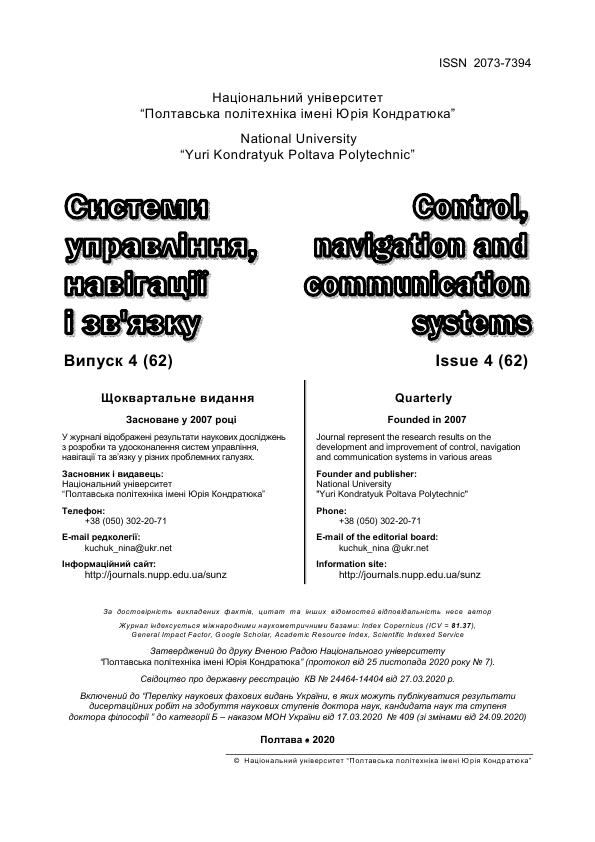ФОРМАЛІЗОВАНА МАТЕМАТИЧНА МОДЕЛЬ ПРОГНОЗУВАННЯ НАДЗВИЧАЙНИХ СИТУАЦІЙ ТА МОЖЛИВИХ ЗАВДАНИХ ЗБИТКІВ ВНАСЛІДОК НИХ
DOI:
https://doi.org/10.26906/SUNZ.2020.4.092Ключові слова:
формалізована математична модель, керуючий алгоритм, надзвичайна ситуація, характер, вид, рівень надзвичайної ситуації, збитки від надзвичайних ситуаційАнотація
Актуальність. Попередження надзвичайних ситуацій ґрунтується на аналізі, прогнозуванні загроз виникнення надзвичайних ситуацій та їх можливих наслідків як в державі, так і її регіонах. При цьому прогнозування надзвичайних ситуацій повинне бути спрямованим на регулювання техногенної, природної та соціальної безпеки в країні, оцінку загрози виникнення надзвичайних ситуацій та їх можливих наслідків. Мета. Розробка формалізованої математичної моделі прогнозування надзвичайних ситуацій та можливих збитків внаслідок них. Метод. Системний підхід до вирішення проблеми прогнозування надзвичайних ситуацій та можливих завданих збитків внаслідок них як в державі, так і її регіонах з метою недопущення їх виникнення або мінімізації можливих наслідків передбачає прогнозування надзвичайних ситуацій в цілому по державі та її регіонах; прогнозування надзвичайних ситуацій природного характеру в цілому, за видами та рівнями в державі; прогнозування надзвичайних ситуацій техногенного характеру; прогнозування надзвичайних ситуацій соціального характеру за видами та рівнями і прогнозування збитків внаслідок надзвичайних ситуацій у державі. Результати. Розроблено формалізовану математичну модель прогнозування надзвичайних ситуацій, можливих завданих збитків внаслідок них та керуючий алгоритм, який реалізує розроблену математичну модель. Висновки. Формалізована математична модель прогнозування надзвичайних ситуацій та можливих завданих збитків внаслідок них включає математичні моделі прогнозування процесу виникнення надзвичайних ситуацій в державі; прогнозування процесу виникнення надзвичайних ситуацій в регіонах держави, прогнозування надзвичайних ситуацій за характером, видами та рівнями як в державі в цілому, так і її регіонах; прогнозування можливих збитків внаслідок надзвичайних ситуацій. Отримані результати дослідження є фундаментом для обґрунтування організаційно-технічних заходів щодо реагування на надзвичайні ситуації з метою їх попередження і мінімізації можливих наслідків
Завантаження
Посилання
Звіт про основні результати діяльності Державної служби України з надзвичайних ситуацій у 2018 році. [Електрон.ресурс]. – Режим доступу: URL: http://www.dsns.gov.ua/files/2018/1/26/Zvit%202018(КМ).pdf.
Звіт про основні результати діяльності Державної служби України з надзвичайних ситуацій у 2017 році. URL: http://www.dsns.gov.ua/ files/2018/1/26/Zvit%202017(КМУ). pdf (дата доступу: 08.08.2018).
Tiutiunyk V.V. Ivanets H.V. Tolkunov I.A. Stetsyuk E.I. (2018). System approach for readiness assessment units of civil defense to actions at emergency situations. Scientific Bulletin of National Mining University. Vol. 1. Is. 1 (163). Pp. 99-105.
Голован Ю.В., Козырь Т.В. Защита населения в чрезвычайных ситуациях. Организационно-методический комплекс. Издательство «Проспект», Дальневосточный государственный технический университет. 2015. 219 с.
Nivolianitou Z., Synodinou B. (2011). A Towards emergency management of natural disasters and critical accidents: The Greek experience. Journal of Environmental Management.. Vol. 92. Issue. 10. pp. 2657-2665. Doi: https// doi: org/ 10.1016/j.jenvman.2011.06.003.
Новоселов С.В., Панихидников С.А. Проблемы прогнозирования количества чрезвычайных ситуаций статистическими методами. Горный информационно-аналитический бюллетень. 2017. No10. С. 60-71.
Ivanets H., Horielyshev S., Ivanets M., D. Baulin, Tolkunov I., Gleizer N., Nakonechnyi A. (2018). Development of combined method for predicting the process of the occurrence of emergencies of natural character. Eastern-European Journal of Enterprise Technologies. Vol. 5. Issue 10(95). pp. 48-55. doi:https://doi.org/10.15587/1729-4061.2018.143045.
Баскин Ю.Г., Горбунов А.А., Савельев Ю.С. Предупреждение чрезвычайных ситуаций природного и техногенного характера. Проблемы управления рисками в техносфере. СП6 No3. СП6 УГПС МЧС России, 2014.
Deng, S.C., Wu, Q., Shi, B., et al. (2014) Prediction of Resource for Responding Waterway Transportation Emergency Based on Case-Based Reasoning. China Safety Science Journal Vol. 24. pp 79-84.
Tsurikov A.N. (2013). Application of artificial neural network for identification of stability of botton layer of atmosphere. Applied and Fundamental Studies: Proceedings of the 2nd International Academic Conference. Publishing House «Science and Innovation Center». St. Louis, Missouri, USA. pp. 226-231.
Vasiliev M., Movchan I., Koval O. (2014). Diminishing of ecological risk via optimization of fire-extinguishing system projects in timber-yards. Naukovyi Visnyk Natsionalnoho Hirnychoho Universytetu. Issue 5. pp. 106–113.
Mygalenko, K., Nuyanzin, V., Zemlianskyi, A., Dominik, A., Pozdieiev, S. (2018). Development of the technique for restricting the propagation of fire in natural peat ecosystems. Eastern-European Journal of Enterprise Technologies.Vol. 1 (10(91)). Pp. 31–37. doi: 10.15587/1729-4061.2018.121727.
Pradhan R.P., Kumar R. (2010). Forecasting Exchange Rate in India: An Application of Artificial Neural Network Model.Journal of Mathematics Research. Vol. 2. No.4. pp. 111-117.
Sun, B.Z., Ma, W.M. and Zhao, H.Y. (2013). A Fuzzy Rough Set Approach to Emergency Material Demand Prediction overTwo Universes. Applied Mathematical Modeling Vol. 37. pp. 7062-7070. http://dx.doi.org/10.1016/j.apm.2013.02.008.
Al-Jumeily D., Ghazali R. (2014). Hussain A.Predicting physical time series using dynamic ridge polynomial neural networks. PLoS ONE. No9: e105766. doi: 10.1371/journal.pone.0105766.
Ямалов И.У. Моделирование процессов управления и принятия решений в условиях чрезвычайных ситуаций. Москва, БИНОМ. Лаборатория знаний. 2015. 291 с.




